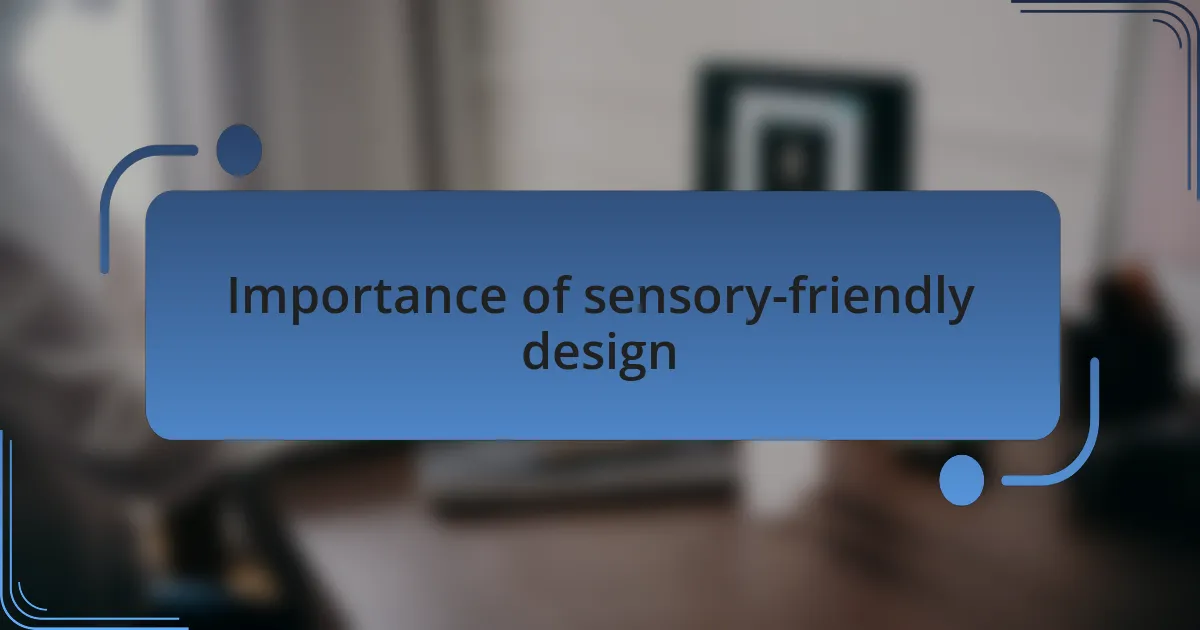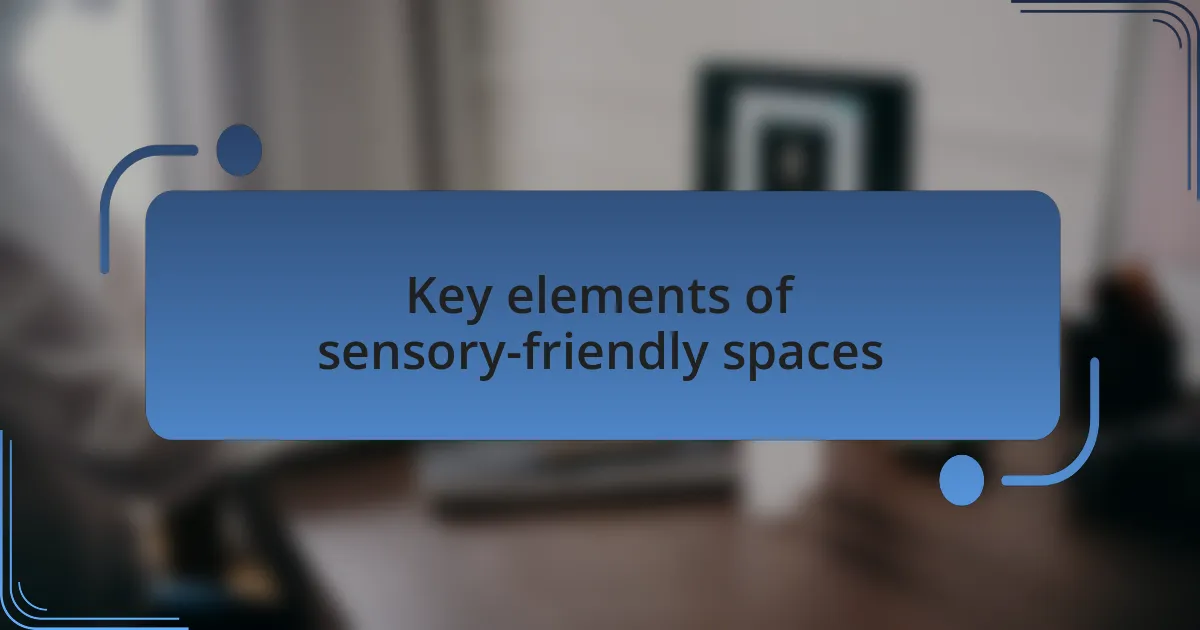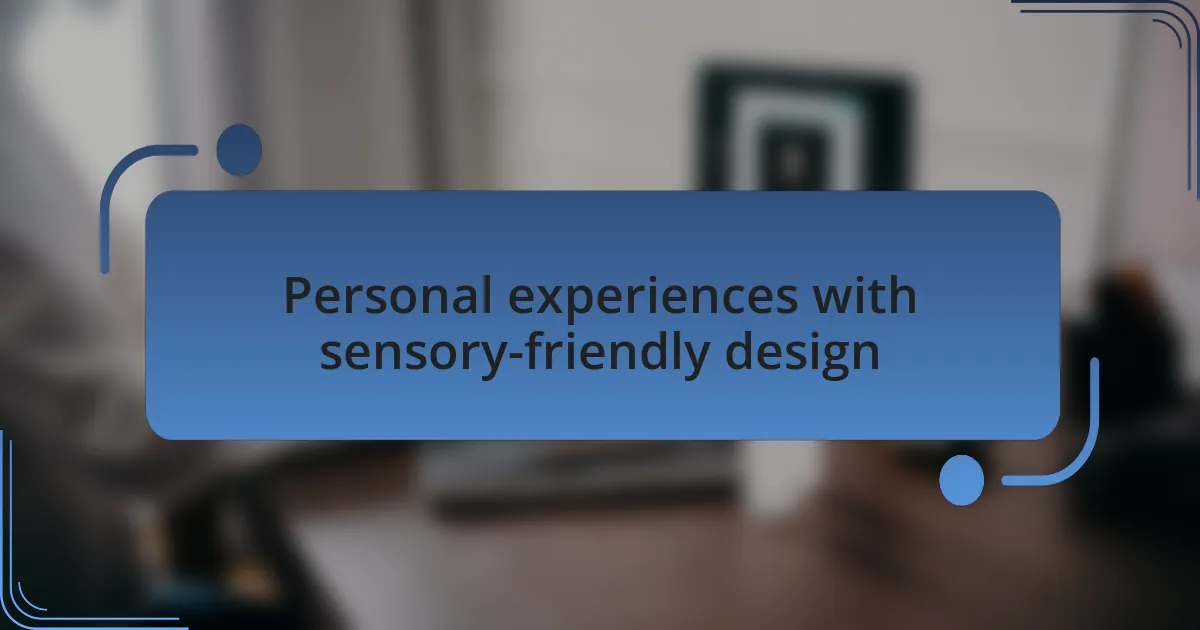Key takeaways:
- Sensory-friendly spaces prioritize individual comfort and accessibility, impacting both physical and digital environments.
- Empathy in design is crucial for creating welcoming spaces that foster a sense of belonging and reduce anxiety.
- Key design elements include thoughtful furniture arrangement, sound management, and effective use of lighting to enhance user experience.
- Sensory-friendly web design promotes user engagement and retention through calming color schemes, simple typography, and intuitive navigation.

Understanding sensory-friendly spaces
When I first learned about sensory-friendly spaces, it struck me how vital they are for fostering comfort and inclusivity. Imagine walking into an environment that feels warm and inviting, where design choices alleviate stress rather than add to it. This realization changed how I approached spaces—not just in physical locations, but also how I perceive digital environments.
Creating a sensory-friendly space is about more than just adjusting lighting or minimizing noise. It’s about understanding the diverse needs of individuals—whether they have sensory sensitivities, anxiety, or other conditions. I remember one workshop I attended where participants shared their firsthand experiences; one person spoke about the overwhelming chaos of typical office environments. It made me reflect: how can we, as designers, ensure that every user feels at ease?
The integration of sensory-friendly elements is not just a trend; it’s an essential shift in how we think about accessibility. As someone who values empathy in design, I often ask myself: Are my designs truly welcoming for everyone? By prioritizing the sensory needs of users, we cultivate spaces that not only please the eye but also nurture the soul. That’s a profound takeaway that stays with me.

Importance of sensory-friendly design
In my experience, sensory-friendly design significantly impacts user engagement and satisfaction. I recall a project where we incorporated softer color palettes and tactile materials; the feedback was overwhelmingly positive. People expressed how the space felt less intimidating and more like a sanctuary, which reinforced my belief that design can fundamentally alter one’s mood and experience.
Empathy plays a crucial role in creating these environments. I once visited a café designed with sensory-sensitive patrons in mind—low lighting, soft seating, and quiet corners. I was amazed at the calm atmosphere it cultivated; it made me ponder the responsibility we have as designers to create such havens everywhere. How often do we consider the emotional weight of our design choices?
The importance of sensory-friendly design extends beyond mere aesthetics; it fosters a sense of belonging. I often think about the stories behind individuals who struggle in overwhelming environments. With mindful design, we can give them the space to thrive. Isn’t it our job to ensure everyone feels like they belong in the places we create?

Key elements of sensory-friendly spaces
When considering the layout of a sensory-friendly space, one key element is the arrangement of furniture and pathways. I remember working on a community center redesign where we aimed to create open spaces that allowed for easy navigation. We strategically placed furniture to avoid clutter, and that simple change made a world of difference. It invited people to explore rather than feel boxed in, showing how thoughtful organization can enhance comfort.
Another crucial component is sound management. In my experience, acoustic panels and soft furnishings play an essential role in absorbing noise. In one of my projects, we installed sound-reducing materials in a busy classroom. The transformation was immediate—students were able to focus better and engage more effectively. Doesn’t it make you think about the power of silence in our designs?
Lighting also deserves attention. I’ve found that natural light can work wonders, but when that’s not possible, layering different types of light is essential. In an art gallery I collaborated on, we incorporated adjustable lighting to suit various exhibitions. The ability to tailor the ambiance helped visitors feel more at ease and present in the moment. Doesn’t it make you wonder how light can influence our emotions and perceptions?

Techniques for web design
To create a web design that caters to sensory-friendly spaces, I focus on color schemes that promote calmness. In a recent project, I chose a palette of soft blues and greens, which not only provided visual appeal but also fostered a sense of tranquility. Have you ever noticed how certain colors can evoke emotions? It’s fascinating how our choices in design can directly impact user experience.
When it comes to typography, simplicity is key. I prefer using easy-to-read fonts with ample spacing, which minimizes visual stress for users. In a past website overhaul, I experimented with various font sizes and styles, ultimately favoring a clean sans-serif typeface. This decision made the content feel more accessible, allowing users to engage with the information comfortably. Isn’t it interesting how small adjustments can enhance readability and ultimately make users feel more at home?
Lastly, I emphasize the importance of intuitive navigation. In my experience, clear menus and straightforward pathways enhance usability, much like how clear signage aids in physical spaces. During a recent redesign for a nonprofit, we streamlined the navigation, reducing the number of clicks needed to access information. The feedback was overwhelmingly positive—users appreciated the ease of finding what they needed. Doesn’t it just resonate when a well-organized space helps us feel more in control?

Personal experiences with sensory-friendly design
One memorable experience I had with sensory-friendly design was during a project for a community center aimed at supporting families with children on the autism spectrum. I advocated for the incorporation of softer lighting and acoustic panels to create a more inviting atmosphere. Walking through the completed space, I felt an immediate shift in my own anxiety levels—can design really affect our emotions that deeply?
Another instance was when I redesigned a website for an arts organization that hosted workshops for neurodiverse individuals. I remember choosing to include gentle animations that would guide users without overwhelming them. The response from participants was heartwarming; they expressed gratitude for the ease of navigation, citing how it helped them focus on the content rather than being distracted by chaotic visuals. How can we ensure our designs genuinely support users’ experiences?
One particular memory stands out from a project I worked on for a health service aiming to support those with sensory sensitivities. We created an interactive feature that allowed users to adjust the color and brightness settings to match their comfort levels. I was genuinely surprised by the community’s response; many shared that this simple control made them feel more empowered and engaged. Isn’t it remarkable how giving users the choice can transform their entire experience?

Benefits of sensory-friendly web design
Creating sensory-friendly web designs not only enhances user experience but also fosters inclusivity. I remember when I integrated a feature that reduced visual clutter on a website for a mindfulness app. The shift in usability was instant; users shared how the calm design allowed them to focus on their mental well-being, rather than being overwhelmed by too much information. This made me ponder, isn’t it essential for websites to cater to diverse needs?
Another benefit I observed was increased engagement. While working on an educational platform, I opted for a color scheme that was both calming and intuitive. The feedback was incredible—users expressed that they felt more comfortable spending time on the site. It’s fascinating to realize how design choices can either draw users in or repel them; isn’t it amazing that something as simple as color can dictate our willingness to engage?
Lastly, I noticed that sensory-friendly web design can boost user retention. During a project for a nonprofit, we focused on clear navigation and straightforward content layouts. Users frequently mentioned they returned because they felt at ease while browsing. This led me to question—if we can create spaces that cultivate safety and ease, aren’t we ultimately enhancing the digital landscape for everyone?